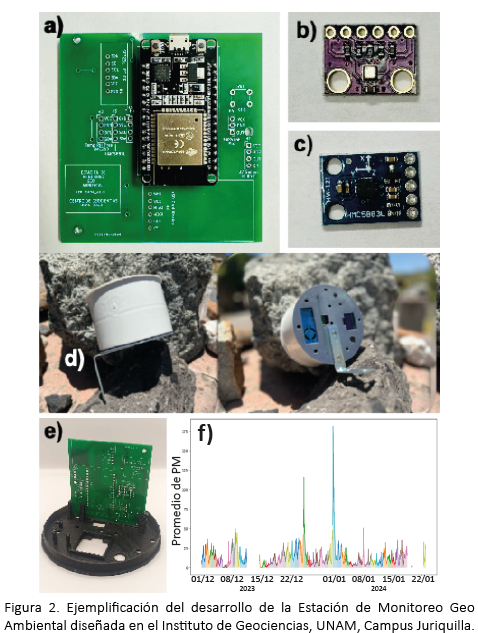Abstract
The development and implementation of low-cost sensors, in combination with microcontroller systems such as Raspberry
Pi, Arduino, and ESP32, have opened new avenues in the field of geosciences, providing accessible and flexible solutions for the
monitoring and analysis of natural phenomena. These platforms allow for the creation of adaptable and customizable monitoring systems capable of recording various environmental parameters, such as temperature, pressure, humidity, and geomagnetic field variations. This article examines the application of these technologies in geosciences, with a particular focus on their advantages and potential uses, primarily emphasizing their low cost and versatility. These features in scientific instrumentation can democratize access to research and promote science-oriented education. Through a case study on the detection of geomagnetic storms using an ESP32 and an HMC5883L magnetometer, the article presents a step-by-step tutorial on how to set up an efficient and affordable monitoring system, with the aim of showcasing its practical applications in both academic and community-based projects. The case study underscores the potential of these tools for conducting preliminary research in resource-constrained environments or as an introduction to more advanced concepts in geosciences.
Although low-cost sensors may be limited in precision compared to high-end equipment used in specialized laboratories, they offer significant opportunities for exploratory research, educational initiatives, and the expansion of monitoring networks in areas with limited technological infrastructure. Their ease of integration and programming, coupled with the abundance of available documentation, make these technologies highly suitable for scientists, educators, and students, providing access to tools that would otherwise be unattainable. In this way, these systems represent a valuable contribution to the advancement of geological sciences and their broader dissemination to diverse sectors of society.
References
Akasofu, S. I. (1981). Relationships between the AE and Dst indices during geomagnetic storms. Journal of Geophysical Research: Space Physics, 86(A6), 4820-4822.
Ahn, B. H., Moon, G. H., Sun, W., Akasofu, S. I., Chen, G. X., y Park, Y. D. (2002). Universal time variation of the Dst index and the relationship between the cumulative AL and Dst indices during geomagnetic storms. Journal of Geophysical Research: Space Physics, 107(A11), SMP-38.
Anthony, R. E., Ringler, A. T., Wilson, D. C., y Wolin, E. (2019). Do lowcost seismographs perform well enough for your network? An overview of laboratory tests and field observations of the OSOP Raspberry Shake 4D. Seismological Research Letters, 90(1), 219- 228.
Cameron, N. (2023). ESP32 microcontroller en ESP32 Formats and Communication: Application of Communication Protocols with ESP32 Microcontroller (pp. 1-54). Berkeley, CA: Apress.
Cerrato, Y., Saiz, E., Cid, C., y Hidalgo, M. A. (2004). Geomagnetic storms: Their sources and a model to forecast the Dst index. Lecture Notes and Essays in Astrophysics, 1, 165-176.
De Plaen, R. S., Márquez-Ramírez, V. H., Pérez-Campos, X., Zuñiga Davila-Madrid, F. R., Rodríguez-Pérez, Q., Gómez González, J. M., y Capra, L. (2020). Seismic signature of the COVID-19 lockdown at the city-scale: A case study with low-cost seismometers in the city of Querétaro, Mexico. Solid Earth Discussions, 2020, 1-17.
Delgado-Castro, A., y Rojas-Bolaños, O. (2015). Construcción de un sistema de bajo costo para el uso y evaluación de sensores semiconductores para gases. Educación Química, 26(4), 299-306.
Hernández-Quintero, E., Goguitchaichvili, A., García-Ruiz, R., Cervantes-Solano, M., y Cifuentes-Nava, G. (2018). Más de 100 años ininterrumpidos de registro geomagnético en México: implicaciones en la datación absoluta de algunos edificios históricos. Arqueología Iberoamericana, 39, 36-43.
Ismailov, A. S., y Jo‘Rayev, Z. B. (2022). Study of Arduino microcontroller board. Science and Education, 3(3), 172-179.
Kaur, K., y Kelly, K. E. (2023). Laboratory evaluation of the Alphasense OPC-N3, and the Plantower PMS5003 and PMS6003 sensors. Journal of Aerosol Science, 171, 106181.
Lazzús, J. A., y Salfate, I. (2024). Report on the effects of the May 2024 Mother's day geomagnetic storm observed from Chile. Journal of Atmospheric and Solar-Terrestrial Physics, 261, 106304.
Maier, A., Sharp, A., y Vagapov, Y. (2017, September). Comparative analysis and practical implementation of the ESP32 microcontroller module for the internet of things. In 2017 Internet Technologies and Applications (ITA) (pp. 143-148). IEEE.
Matzka, J., Bronkalla, O., Tornow, K., Elger, K., y Stolle, C. (2021). Geomagnetic kp index. GFZ German Research Centre for Geosciences, 11.
Rani, S. U., Rajarajeswari, S., Jaimon, J. G., y Ravichandran, R. O. S. H. A. N. (2020). Real-time air quality monitoring system using MQ-135 and thingsboard. Journal of critical reviews, 7(18), 4107-4115.
Richardson, M., y Wallace, S. (2014). Getting Started with Raspberry Pi: Electronic Projects with Python, Scratch, and Linux. Maker Media, Inc.
Rodríguez-Trejo, A., Böhnel, H.N., Ibarra-Ortega, H.E., Salcedo, D., González-Guzmán, R., Castañeda-Miranda, A.G., Sánchez-Ramos, L.E. y Chaparro, M. A. E., (2024) Air quality monitoring with lowcost sensors: a record of the increase of PM2.5 during Christmas and New Year’s Eve celebrations in the city of Queretaro, Mexico. Atmosphere 2024, 15, 879. https://doi.org/10.3390/atmos15080879
Rostoker, G. (1972). Geomagnetic indices. Reviews of Geophysics, 10(4), 935-950.

This work is licensed under a Creative Commons Attribution-NonCommercial 4.0 International License.
Copyright (c) 2024 Universidad Nacional Autónoma de México

